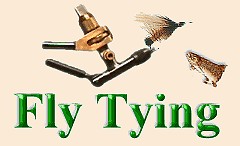|
Everyone has an opinion on what hackle to use for soft hackle flies and Nymphs.
The one question I am asked most by tiers concerns Hen Hackle. So I will attempt
to give some of my thoughts on the subject, one of our most popular packages
of hackle are our JV Hens.
I personally have used hen hackle for wings on both dry flies and
wet flies. The wing does not float the fly so I believe a tier can use
whatever he or she wants for a wing. We were the first and only
breeder to offer the true genetic hen on the market.
How does one tell a hen hackle from a rooster hackle? At a very
early age we can sex our birds (after the baby fuzz is replaced by
real feathers) by just looking at them. For most people the bird needs
to be over 12 weeks of age before it is obvious, but we can see the
difference much earlier.
The males always have a very sharp pointed end. (Both cape and
saddle feathers). The hens are always round on the ends. Quite
simple but not really easy to determine unless you look at a lot of
birds. Once the bird gets older it is quite obvious.
Our dry fly roosters (genetic) have no barbicels on the barbs of the
cape and saddle feathers, making them dry fly quality. The hens and
a high percentage of other feathers on the rooster do have the
barbicels, making them wet fly quality. All hen feathers are wet quality.
Another difference is the rooster barbs are very stiff where the hen
feathers are quite soft. The roosters dry fly hackle being stiff and a
unique point on the end of the barbs, which allows the fly to sit in
the film of the water. (Unless you trim the tips off) The soft barb
of the hen, when wet tends to soak up water and lay back onto
the body of the fly. These barbs do undulate when the fly is worked
through the water. Knowing this I feel it may be an advantage to tie
hen hackle at least 2 times the width of the gape of your hook.
Standard is 1 ½ times for the dry fly. Try it and you might be
surprised at the results. Another tip is when tying a soft hackle fly,
do not bind down the hackle collar when whipping in the head. Stay
off the hackle. Some teach to tie back on the hackle to make it look nice?
To a fisherman or fish? Just one of my observations. Allow the barbs
to undulate naturally.
Some hen hackle offered on the market are produced from Bantams
or barnyard breeds, not from the genetics like we do. Yes, some of
these different breeds do dye into beautiful colors but the stems are
very user-unfriendly. We have put so much time and money into our
dry fly stems that I felt we should use the genetic hens for our JVs
and Mature hens.
Stems: Our JVs and Mature genetic hens have the same user-friendly
stems that we have bred into our genetic roosters. Very fine and supple.
I used to use Huns and different game birds and always had to fight the
feather as I tied the fly. Huns have stems like broom handles making life
at the vise very uncomfortable. Just my opinion.
One can tie soft hackle flies from both the cape hackle and the
saddle hackle of the hens. The only real difference between JVs
and Matures is the size of the saddle hackle. They are small enough
to use from the JVs without cutting as wings and the total number of
feathers (cape and saddles) per bird. The Mature has a lot more
useable feathers because they are older and therefore larger.
Here is an interesting fact: Colors are not the same from the hens
and roosters. The Black is the only one that is the same. We have
far more shades of dun in a hen than we can produce in the Roosters.
A brown rooster is not the same color as a brown hen. Differences
in shades. We dye none of our hackle but do find we can come close
enough to a color of a soft hackle fly that we do catch a lot of fish.
Some colors we know as dry fly tiers just do not happen in the hens.
No, as of yet I have not been able to produce an olive or chartreuse
in either the rooster or hens. We are trying but—
We do try and keep a good stock of our JV hens but tend to run out
of many of the hot colors. Normally we are always processing the new
JVs about Sept first. Many customers from all over the country and
many different countries have switched to our Genetic hens for tying
soft hackle flies.
I am always willing to talk about them. Just give me a ring and I will
answer: 509-999-7472. ~ Denny Conrad
Back to the Main Page
|

